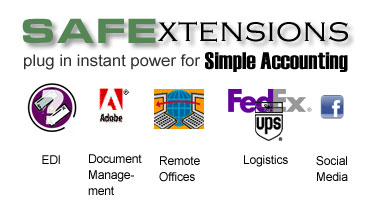Editing a General Ledger Account
Despite the preceding verbiage, the actual process of adding and editing accounts is very simple. Since most attributes of an account are inherited from its parent, adding a new account is usually just a matter of cloning an existing account with similar attributes and adding a new ACCOUNT and DESCRIPTION.
Fields
|
DESCRIPTION |
The title of this account as it will appear on financial reports.
|
|
ACCOUNT |
The account number or alphanumeric ID. This can be any convenient eight digit shorthand for the account’s function. If you already have an established account numbering system, you can continue to use that here. Searches from browse boxes are done using this field, so it makes sense to use accounts which are easy to remember. Once Again: The account does not determine the placement (or position) of the account within the chart.
|
|
PARENT ACCOUNT |
Indicates the summary account to which this account is subtotalled. A browse is available to help you select a valid parent. Leave this field blank for top level accounts.
|
|
TYPE |
Select either: Asset, Liability, Capital, Revenue or Expense. This is automatically inherited from the parent account. The Account Type also affects how the account’s balance is handled at the end of each Period Update. Asset, liability, and capitol account balances are carried forward to the next period for use on the balance sheet. Revenue and expense accounts are zeroed out to begin each accounting period.
|
|
DEPARTMENT |
Optional. Enter an ID for this accounts Department if you wish to be able to print separate Financial Statements for separate parts of your company (such as branch offices.) TIP: Use the drop down listbox to create new Departments. |
|
CATEGORY |
Optional. Used strictly for reports to group accounts together. Example: You may wish to identify particular accounts as no longer being used. You could do this by typing OBSOLETE into this field for those accounts.
|
|
PRINT ON FINANCIAL REPORTS? |
Should this account print on your financial statements? For most working accounts (those into which you actually make entries) this field should be checked. Example: You may have several sales accounts which all clear to a Total Sales account. On your income statement you only want the Total Sales number to print and not the individual sales accounts. In that case you would check this field for the Total Sales account and leave it unchecked for the actual working accounts.
|
|
TOTAL ON FINANCIAL REPORTS? |
Check this field if the account is totalled on financial reports such as the Income Statement, Trial Balance or Balance Sheet. This box is normally checked for all accounts which will appear on your financial statements (children accounts). You should probably not check this box if the account is a parent account which is for display purposes only. When this box is not checked, the account displays on the report, but is not part of any calculations and no numeric fields (balance, YTD activity, etc.) are displayed. This lets you present the parent accounts for what they are: group headers which enhance readability, but without their affecting the totals of the report. |
 POSITIONING OF ACCOUNTS While you search for and identify accounts by their DESCRIPTION and ACCOUNT fields, the position (where an account appears) of each account within the chart is not determined by these fields. Instead, the position is determined by two fields: HORIZONTAL POSITION and VERTICAL POSITION. This avoids the problems of running out of account numbers, or of what to do if you need to re-organize your chart. This allows you to freely position any account anywhere you like on your Financial Statements.
POSITIONING OF ACCOUNTS While you search for and identify accounts by their DESCRIPTION and ACCOUNT fields, the position (where an account appears) of each account within the chart is not determined by these fields. Instead, the position is determined by two fields: HORIZONTAL POSITION and VERTICAL POSITION. This avoids the problems of running out of account numbers, or of what to do if you need to re-organize your chart. This allows you to freely position any account anywhere you like on your Financial Statements.
|
VERTICAL POSITION |
This field determines the order in which an account will appear in the chart Remember, the larger the number in this field, the lower the account will appear on the list. The lower the number, the nearer it will print to the top. This allows you to shuffle the appearance of your financials without tampering with the actual ACCOUNT IDs.
|
|
HORIZONTAL POSITION |
This field determines how far indented (from the left) the account appears in the chart. This makes it easier to see the relationship of an account within its group. Enter a number between one and nine (1-9) where one is not indented (highest level group) and nine is at the bottom. Normally, the HORIZONTAL POSITION of an account is always one greater than that of its parent.
|
|
DEBIT/CREDIT |
Determines whether the default entry for this account is a debit or a credit. It also determines whether a debit or a credit balance should be displayed as a positive number on financial reports. Typically assets and expense accounts are set to Debit while liability, capitol and revenue accounts are marked Credit to indicate that they will normally have a credit balance on financial statements. Example: While most other revenue accounts are credit accounts, the sales discount account, is a debit account since entries to it are usually entered as debits. |
IMPORTANT TOTALS & DATES
The following fields are automatically updated as you use Simple Accounting. They may not be directly edited.
|
LAST ENTRY DATE |
The last date an entry was made to this account.
|
|
LAST DATE POSTED |
The last transaction date posted to. Whereas the LAST ENTRY DATE indicates the actual date the transaction was entered, LAST DATE POSTED stores the date the operator used for the transaction. Example: On January 21, 2001 Sue entered a transaction for a December 31, 2000s Insurance Payment. In that case, the LAST ENTRY DATE would be 01/21/01 and the LAST DATE POSTED would be 12/31/00.
|
|
LAST CLOSE DATE |
The last time a Period Update was performed updating this account.
|
|
LAST REVISION DATE |
The last date on which this account was edited in this screen.
|
|
LAST REVISION TIME
|
The last time on which this account was edited in this screen. |
|
MTD ACTIVITY |
Net dollar amount of transactions for this account for the current month (period).
|
|
YTD ACTIVITY |
Net dollar amount of transactions for this account for the current year.
|
|
LAST YEAR ACTIVITY |
Net dollar amount of transactions for this account for the previous year.
|
|
CURRENT BALANCE |
The current balance of this account.
|



